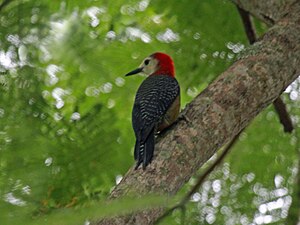Jamaican woodpecker
| Jamaican woodpecker | ||||||||||||
|---|---|---|---|---|---|---|---|---|---|---|---|---|

Jamaican Woodpecker ( Melanerpes radiolatus ) |
||||||||||||
| Systematics | ||||||||||||
|
||||||||||||
| Scientific name | ||||||||||||
| Melanerpes radiolatus | ||||||||||||
| ( Wagler , 1827) |
The Jamaican Woodpecker ( Melanerpes radiolatus ) is a species of bird from the family of woodpeckers (Picidae). This medium-sized species of woodpecker is endemic to Jamaica . The animals inhabit a wide spectrum of tree-dominated landscapes from mangroves and montane rainforests to tree-lined pastures, lemon and coconut palm plantations . Jamaican woodpeckers eat many types of fruits and berries, as well as insects and other invertebrates, especially grasshoppers, butterflies, beetles and their larvae. In addition, small lizards are also captured. The species is relatively common and is classified by the IUCN as ![]() (= least concern - not endangered).
(= least concern - not endangered).
description
Jamaican woodpeckers are medium-sized woodpeckers with a long, pointed beak that is quite broad at the base. The ridge of the beak is bent downwards. The body length is 24–26 cm and the weight 92–131 g; they are thus somewhat larger than a great spotted woodpecker and significantly heavier. Like most woodpecker species, the species shows a clear sexual dimorphism in terms of coloration. Females are also slightly smaller and lighter than males.
In both sexes, the entire upper side, including wings and tail, is finely cross-banded in white on a black background, the banding is only missing on the outer hand wings . The underside of the trunk is predominantly monochrome, dark olive. The leg fletching, the abdominal sides and the rear flanks show a blackish, arrowhead-like banding on this basis. The middle of the abdomen is diffuse yellow to reddish. The lower wings are brownish black with white transverse bands. The underside of the tail is a little lighter brown-black than the upper side with an olive tone on the outer feathers.
Males are almost monochrome white at the base of the beak in front of the eye, on the chin and throat and on the sides of the head, with a gray or olive tone on the rear ear covers. The front skull is also whitish, the rest of the skull, back of the head and neck are bright red. In the female, the top of the head is gray or dark gray, sometimes with a brownish tinge or partly black, the red color is limited to the back of the head and neck.
The beak is black, legs and toes are slate black. The iris is red, in juveniles brown, the eye ring gray to brown. The intraspecies variability is very low and no subspecies are recognized.
Vocalizations
A number of calls are known for the species, especially a loud "kääää" that is sometimes repeated two or three times . A particularly loud "kääääh" apparently serves to demarcate the area. During the breeding season “kirr, kirr” or “wii-chä, wiichä” is called out. Both sexes drum in the breeding season.
distribution and habitat
This species of woodpecker is endemic to Jamaica and is the only species of woodpecker there. The total distribution area covers only about 11,000 km². The animals inhabit a wide spectrum of tree-dominated landscapes from mangroves and montane rainforests to tree-lined pastures, lemon and coconut palm plantations .
nutrition
The foraging takes place mainly on trees, mostly at the base and at the ends of branches in the middle of the canopy. The food is mainly obtained by snapping (in the case of fruit) and probing or poking, less frequently by chopping and reading and occasionally when flying. These woodpeckers eat many types of fruits and berries, as well as insects and other invertebrates , especially grasshoppers, butterflies, beetles and their larvae. In addition, small lizards are also captured. Plant material makes up about half of the diet.
Reproduction
Jamaican woodpeckers live in pairs. The breeding season extends from December to August, clutches are formed between January and July. The caves are usually created at a height of 5–10 m in dead trunks, in dead branches of living trees or in wooden stakes. Both partners participate in the cave construction, but the male has a larger share of around 66%. The clutches include three to five eggs. The young hatch 13 days after the first egg is deposited, so the breeding season is only about 10 days. During the day, both partners breed in roughly equal parts, but at night, as with many woodpecker species, only the male breeds. The nestling period is around 31 days. Both partners provide the nestlings with food, the male is also more active here. The young birds stay with their parents for about a month after they leave. Second broods occur, third broods have also been proven.
Existence and endangerment
There is no information on the size of the world population, but the species is quite common. The population trend is presumably decreasing, but overall the Jamaican woodpecker is still classified as safe ("least concern") by the IUCN .
swell
Individual evidence
- ↑ The Jamaican Woodpecker at BirdLife International. Retrieved July 24, 2010
literature
- Hans Winkler , David Christie and David Nurney: Woodpeckers. A Guide to the Woodpeckers, Piculets, and Wrynecks of the World. Pica Press, Robertsbridge 1995, ISBN 0-395-72043-5 , pp. 60-61 and 208.
Web links
- Melanerpes radiolatus in the endangered Red List species the IUCN 2009. Posted by: BirdLife International, 2009. Accessed July 24 of 2010.
- Videos, photos and sound recordings on Melanerpes radiolatus in the Internet Bird Collection